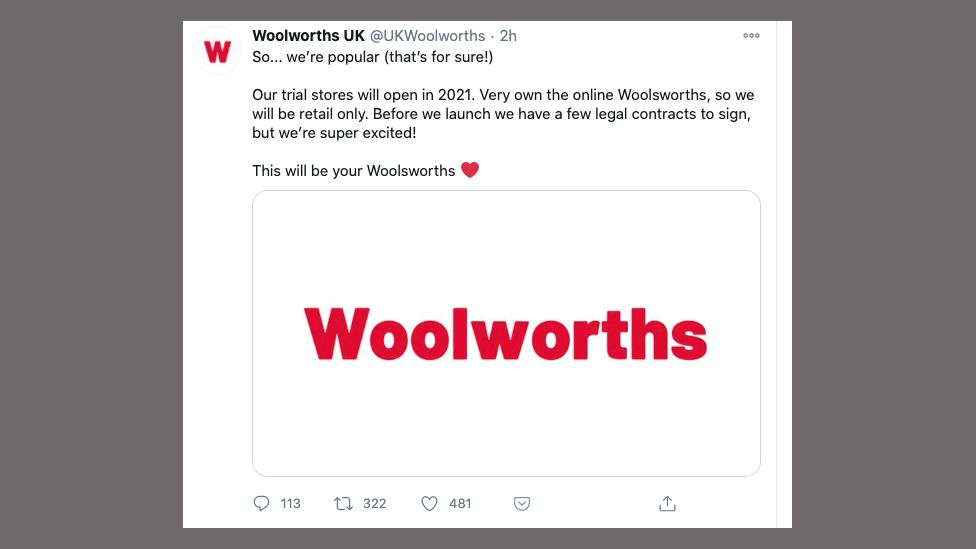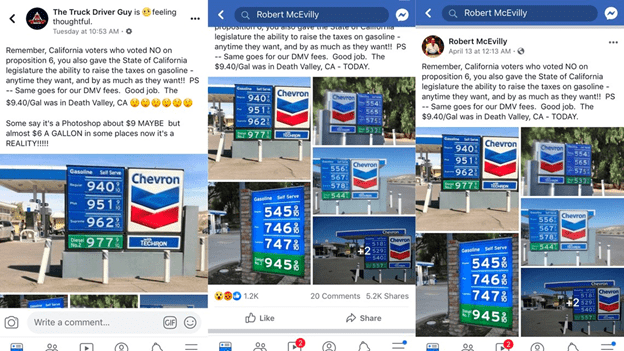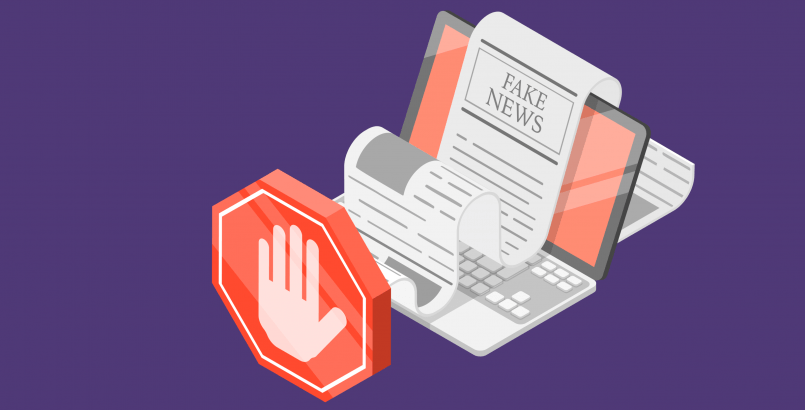The fact that you are an IT person does not mean that you can immediately spot fake news. In these times when we are surrounded by fake news from far and wide, it’s even more difficult to differentiate the truth from completely fictitious news stories. Only a quarter of US citizens are able to recognize fake news. According to Statista, social media is the least trustworthy news source. In 2019, however, 52% of Americans sometimes got their news from social media.
The origin of fake news
The first time the world generally got to know about fake news was in the 2016 presidential elections. By 2020, almost 80% of Americans found at least a few fake news stories concerning the COVID-19 outbreak. Furthermore, what has been highlighted, is that fake news increasingly determines our behavior, votes, and opinions. 83% of Europeans describe fake news as a threat to democracy. What’s more, social media’s ubiquity has only accelerated the pace in the spread of fake news. One such article, about a covid vaccine that alters DNA was shared 352,000 times on Spanish social media before it was taken down by Facebook.
Surprisingly, from 2016 to 2019, the amount of people who claimed that they could distinguish fake news from real news stories rose. In 2019 over 50% of respondents were somewhat confident about spotting fake news, in comparison to 45% in 2016. And almost a half of German citizens claimed they could make a distinction between real and made-up news. Moreover younger generations are more likely to underestimate the potential influence of junk news. Among a group aged between 18-29 years old, only 33% were ‘very concerned’ in comparison to 64% in an age group of over 65s.
How often can you come across fake news?
You can come across completely fictitious information more often than you might think. According to Statista data, 60% of Europeans have experienced fake news at least once a week. In the UK, 45% of adults encounter junk news (poor journalism) daily, so the situation is even more severe. And 15% claimed to be exposed to completely bogus news the previous week. Furthermore, the percentage of Americans who trust national news has declined by 18% between 2016-2021. During the COVID-19 pandemic (2020) almost half of American society faced some fake news stories regarding the virus.
Six tips on how to not be taken in
Taking into account all these negatively framed threats and statistics, here are six tips on how to make your way through a world dogged by fake information.
1. Have you just had a brush with an opinion or facts?
That is the first question that has to pop into your head when you are reading an article or scrolling the news feed. Most fake news is opinions, with an absence of evidence connected to relevant research or scientific sources. If you are sure that a certain piece of information is opinion, then it’s a reason to be more cautious.
However, be careful because some fake news contains quotes or sentences that look like ‘facts’ to give the impression that the item is indeed fact-based. The post can be based on the words of a non-existent physician or documentation that can’t be found anywhere else. Furthermore, one of the current fake news techniques is facts manipulation, when genuine sources are quoted but used in a misleading manner.
EXAMPLE:
In February 2022, Queen Elizabeth II was tested positive for COVID-19, however, she still was carrying out her official light duties. No sooner was the information published by Buckingham Palace spokesperson than rumors that the queen is dead began to swirl. After verification, this story, of course, turned out to be a hoax.

2. Spotting a hidden attack on a certain group
The vast majority of respectable journalists have integrity and try to be impartial. Fake news, however, is the complete opposite. People who produce fake news are as biased as it is possible to be. A popular practice is to deliver a news theme to hurt certain groups.
When you spot such practice, you can be sure that the aim is to increase social polarization. As was highlighted in the introduction, fake news is considered to be a threat to democracy. It was clearly visible in major socio-political events such as the 2016 US election, Brexit, and the Yellow Vests (Gilets Jaunes) movement in France. In all three countries the level of trust in the media plummeted and continues to do so.
EXAMPLE:
In 2017 a US news story which reported that a Muslim refugee had beaten a pregnant woman in Oklahoma rapidly went viral. It turned out that the story was completely fictitious as was the accompanying photo, which was taken from a 2014 movie. It’s an example of news that targets and harms certain groups.

3. Cross-check with another source
There may be a strong temptation after reading a news story to immediately start looking for another or instantly share the story with a friend. But before doing so, wait for a moment and rethink whether the information you have read can be trusted. The easiest way to do this is to cross-check it with another source.
When you find something on Facebook and Instagram do a little research on the internet and confirm or reject the news story. A study showed that mainstream media are perceived to publish fake news ‘most of the time’ by 26% of respondents, and ‘sometimes’ by 31% of respondents. This means that some information you would be looking at could, to a certain degree, be untrue.
To ensure that news is relevant use a good source for your research. Trustworthy sources include fact-checking websites, which operate in almost every country, are predominantly crowdfunded, and should be politically bias-free.
EXAMPLE:
In 2020 there was a fake news story concerning the return to the high streets of the much loved British chain store, Woolworths. The discount chain had closed in 2008, owing £385mln.In fact, the news story, published on a small Twitter account, was written by a 17-year old student. The major newspaper that went on to republish the story failed to do any cross-checking.


4. Notice when the article evokes strong emotions and works on an instinctive level
If you have the feeling, after reading a news story, that you want to negatively comment or share the story immediately, it could be a sign that you are facing something that was only made for catching your attention. Social media looks for any opportunity to evoke strong emotions because it pays in more likes and shares. This is the harsh reality.
Two emotions work best in the media: anger and sadness. People most willingly react when encountering these two feelings, and fake news fits the bill perfectly. Every time you feel deeply troubled about the news you have read, and feel tempted to share it with friends, verify that it’s true. This instinctive trigger in such situations could be a sign that this story is fake.
EXAMPLE:
There are certain topics that add fuel to the fire and one of these is in fact connected to gasoline. In every country where gas prices have risen there has been a wave of discontent. There was news about gas selling for $9 a gallon in California in February 2022 with photoshopped gasoline prices. The aim of the posts was to feed social polarization across the country.

5. Check the image’s source
Nowadays, a fundamental part of media coverage is the image. Fake news sites use images extensively to evoke strong emotions. A huge number of photos utilized in fake news stories are photoshopped or cropped from other images. If you encounter a controversial post, look closely at the photos, maybe you will spot that they aren’t genuine. (Like in the image above, a closer look reveals that those numbers don’t look real).
Another very common practice is using a real photo in a non-related context or manipulating its original purpose. Often, photos from wars from the early 2000s are published now in order to illustrate today’s conflicts. The same case is with mass protests, climate change, and other issues. The remedy for this is a tool called “Google Reverse Image Search”, which enables you to search for when the photo was first used and in what context.
It is important to highlight that videos can also be fake (known as deepfakes). Due to AI algorithms very accurate and convincing fakes can now be produced. Unfortunately, most of us cannot distinguish between a deepfake and a video that has not undergone such a process.
EXAMPLE:
An excellent example of a fake photo is the ‘Rainbow mountain in Peru’ from March 2022. In the comparison below, you can see the fake photo on the left and the original view of Rainbow mountain on the right. We have added two more photos of Rainbow mountain. In the photo on the right, you can clearly see that the colors are more vibrant and the people have been removed. It isn’t a fake but nonetheless it is a slightly photoshopped photo.


6. Simply use common sense
Obvious right? But how many people forget about it when encountering dubious posts or articles. Be more alert. A lot of CAPS as well as spelling mistakes are signs that it could be fake. Some fakes are cranked out by bots that don’t know grammar very well. A very short analysis can help in quickly assessing information. Many sites with fake news use a lot of popups, display aggressive and crude ads, just to catch the reader’s attention.
Furthermore, when you read widely shared news stories, which borders on the conspiratorial, ask yourself: does it all make sense? This is illustrated by the example from tip no. 1. How is it possible that a gossip portal knows and has ‘exclusive’ information about the Queen’s death? And why hadn’t any other reputable media reported this story? IMPOSSIBLE. Fakes are stories that are mostly unreal and impossible in any circumstances.
EXAMPLE:
People catch themselves believing in such absurd fake news because they don’t use common sense. Look at the examples below, connected with the current war in Ukraine. Users share them willingly but after thinking for a while, they look 100% fake.

Don’t share!
After reading Talent Alpha’s six tips, you have to be more prepared for facing the deluge that is fake news. Every important social event brings the threat of mass disinformation, so being on your guard is crucial. And most importantly, remember that you are not only a recipient of news but also a forwarder. Shockingly, 10% of Americans adults admitted that they shared fake news deliberately. Don’t repeat this mistake. Be responsible and prevent the widespread dissemination of news that can be a real danger for society.


Read also
The Human Cloud Ecosystem - Re-Shaping the Business World
Although cloud service was already on the rise before the pandemic, it wasn’t a necessity for many of the people in the industry. What has changed since then?
How Cloud Technology Became More Human
Working remotely has never been as popular as it is now, clearly demonstrating that its perks outweigh its disadvantages. Read more about it here.
VIDEO: Bridge Your Tech Talent Gap Webinar
On Wednesday March 3rd, Talent Alpha hosted our webinar Talent Intelligence in 2021: Understand, Unlock & Unleash Hidden Value in Your Organization